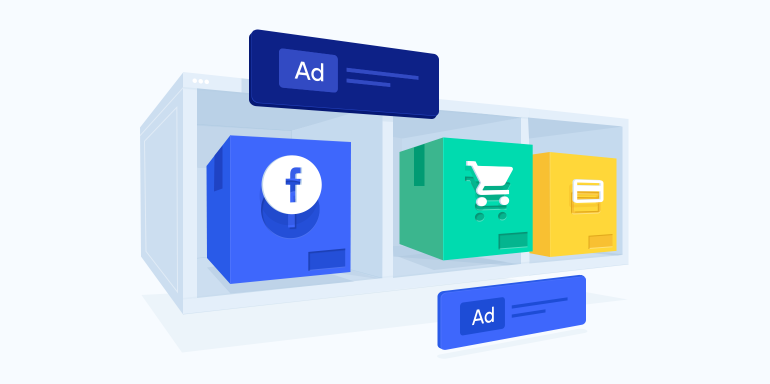- What is Facebook Marketplace?
- What are Facebook Marketplace ads?
- How do they compare to boosted listings?
- Benefits of Marketplace ads
- Reach customers when they’re shopping
- Build personal connections
- Scale ads with automatic placements
- Produce more efficient outcomes
- Benefits for property managers & car dealerships
- How to post ads
- Ad specs
- 2 Important best practices
- Example: Thread Wallets
- Example: FabFitFun
- Example: BarkBox
- Conclusion
There are plenty of intent-based advertising platforms out there — Google and Facebook top of the list.
However, in many markets, reaching people on Google costs a lot more than it does Facebook. Plus, targeting people who are actively searching for something is more effective than targeting people who might be interested in something. That holds for online users across many platforms, including Facebook.
Enter Facebook Marketplace.
What is Facebook Marketplace?
Facebook Marketplace was introduced in 2016 as an alternative option to buying and selling products through user-created Facebook groups. Instead of posting in a single group, anyone can now list a product publicly on the Marketplace and connect directly with potential customers in their area:
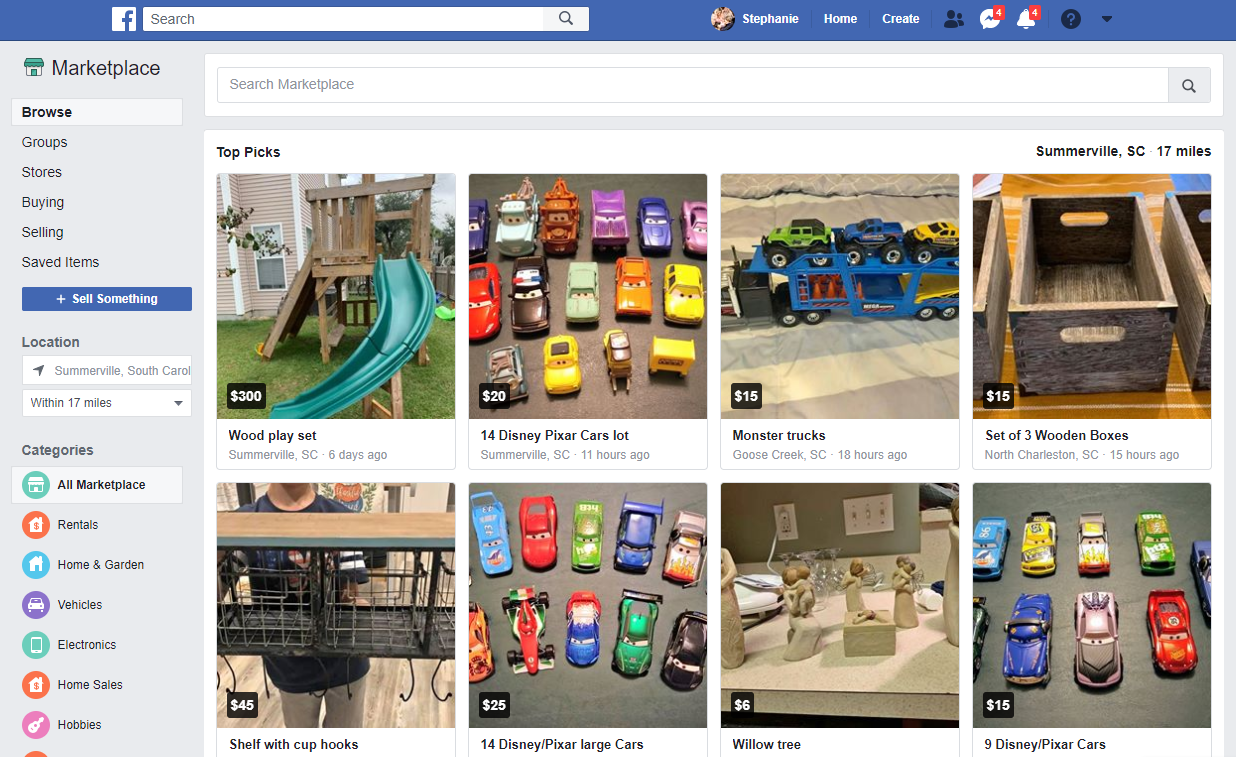
Marketplace is Facebook’s equivalent to eBay and Craigslist — an open-exchange where users can buy and sell new and pre-owned items to other users.
Users can browse different home, vehicle, and various ecommerce categories and subcategories, and then each option tailors the products shown to a specific user’s likes, interests, and activity on Facebook:
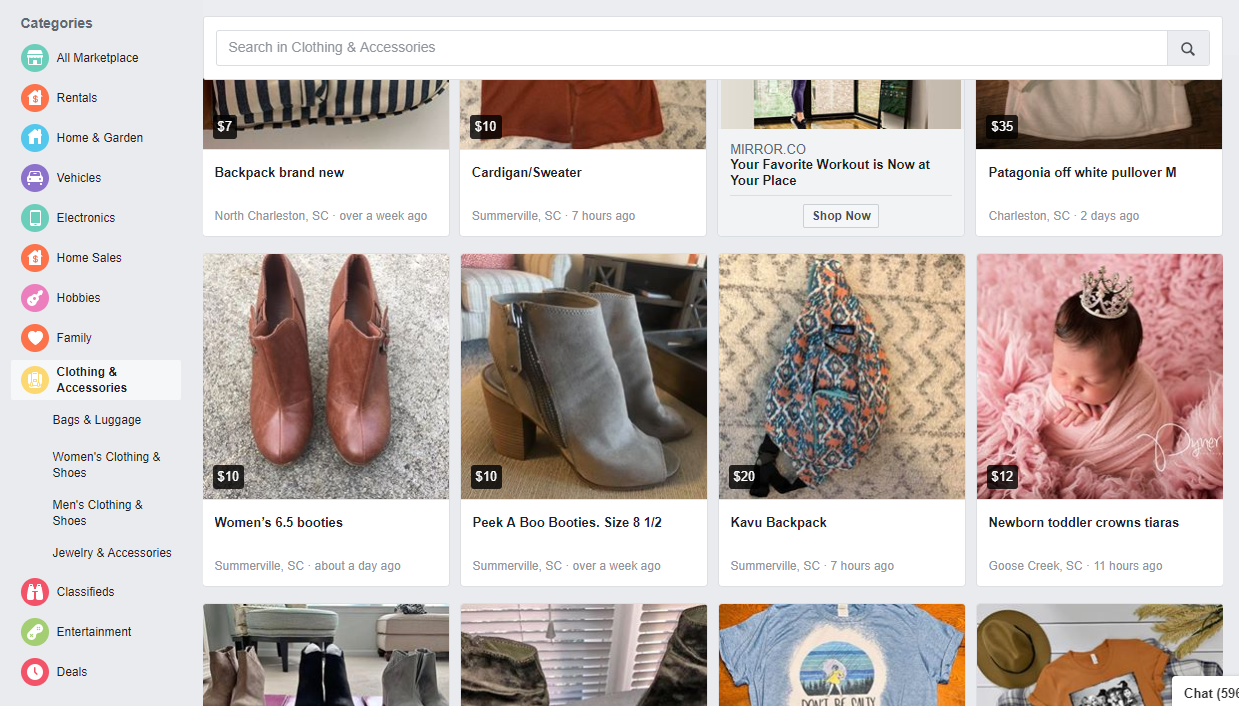
Shoppers can filter searches by price, location, etc., save listings for future reference, and share listings with other people who might be interested.
Facebook Marketplace is a growing community of qualified buyers who are itching to make a purchase. In fact, by 2018, the platform had 800 million monthly users in 70 countries. Now, it is used in 90 countries, and over one-third of Facebook members in the United States use Facebook Marketplace.
Combine this growth with the platform’s built-in interest targeting and easy-to-use product categorization — it’s no wonder that many brands have taken advantage of Facebook Marketplace ads.
What are Facebook Marketplace ads?
These are paid ads that appear between regular product listings on Marketplace (mobile only), helping businesses reach more users where they’re already scrolling and shopping with purchase intent. While Facebook Marketplace paid ads appear among other relevant products, they are set apart by their larger size and a Sponsored label:
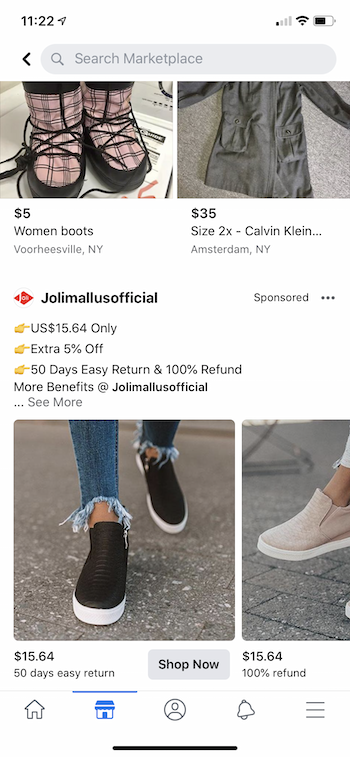
Facebook Marketplace sponsored ads are available through the Ads Manager, just like all the other ad formats. Advertisers design and create their own ad set, define their budget, and select an ad placement. Facebook recommends the Automatic Placements setting so that ads will appear across different placement options such as News Feed, Instagram, Messenger, Audience Network, and Marketplace.
Note: Marketplace ads also appear as News Feed ads, because it’s not currently possible for ads to only show in Marketplace.
How do they compare to boosted Marketplace listings?
Facebook’s Marketplace also allows individual users (not brands) to pay to promote their products — to run ads. They can boost their existing Marketplace listings to increase reach so their products can potentially sell faster. These boosted listings are marked with a “Sponsored by seller” label under the post:
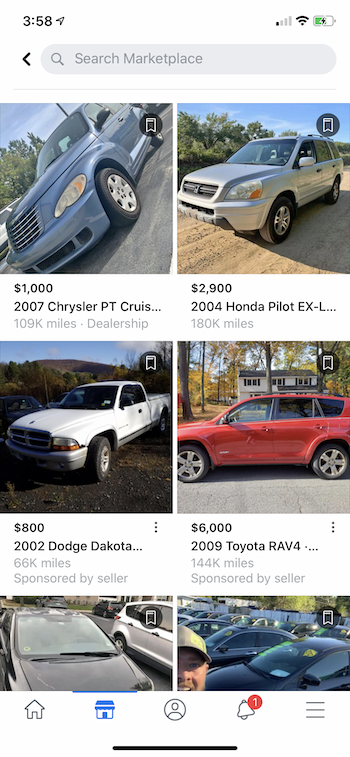
They must comply with Facebook’s ads policies just like all other ads on the social network.
The boosting process is simple. All sellers must do is choose how much they want to spend and how long they want the boost to run. This level of simplicity could entice more everyday Facebook users to spend the money to generate extra exposure for their listings.
However, targeting options are limited, which could also limit effectiveness. Boosted listings appear to people 18 years and older in nearby zip codes, and they automatically use the price, title, photos, and description included in the listing. There aren’t any additional targeting options beyond these.
According to TechCrunch, boosted listings could be helpful to someone trying to quickly liquidate furniture or sell items before moving out of a home — or trying to sell something at a high price, like with the housing or vehicle options. Yet, the lack of targeting could make them less effective for many brands because a listing for women’s fashion boots, for instance, might show up for men.
In contrast, Marketplace ads are not a matter of promoting the item you’re selling on Marketplace like boosted listings are. They are ads that you are otherwise displaying to the Facebook News Feed, Instagram, and Audience Network — just in one additional place.
That said, let’s look at some of the reasons you should start running Marketplace ads through your business page.
Benefits of Facebook ads in Marketplace
1. Reach customers where they’re actively shopping
While Facebook offers many ad placement options, what makes Marketplace unique is that most users who are browsing or searching here, already have purchase intent. They’re actively looking for products to buy, and are therefore more likely to click an ad and purchase the advertised product when they see it alongside other relevant products and services.
2. Build personal connections
Since Facebook is primarily a social network, advertising on Marketplace still focuses on building personal connections with a target audience. Whenever someone wants to purchase on Facebook Marketplace, it’s typically done directly through Messenger or by clicking through to a post-click page.
Transactions through Messenger keep users on the Facebook app, and allow sellers to engage with potential customers on a 1:1 basis, fostering strong relationships with them and increasing their chances of buying.
When an ad takes people away from the Facebook app, businesses should be sure to connect them to a dedicated post-click landing page where they can continue fostering those strong relationships and increase the chance of conversion:
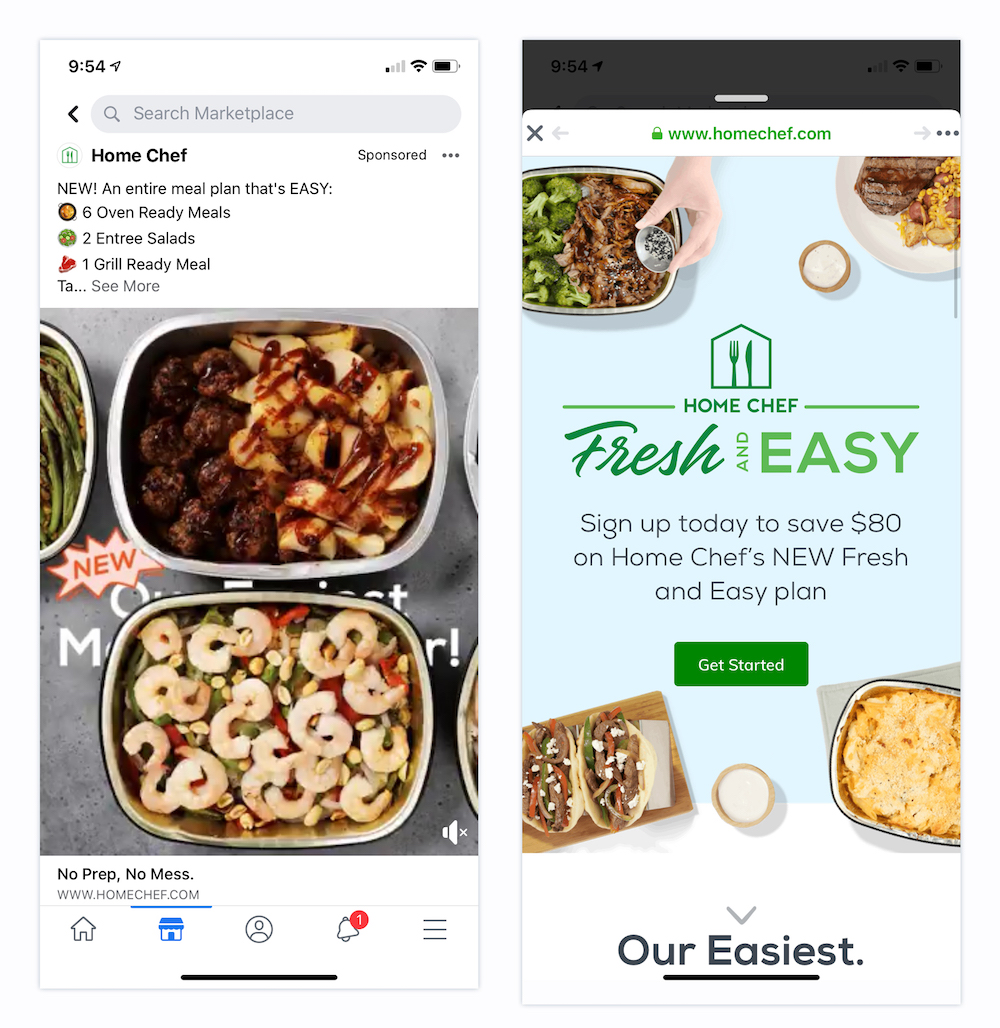
3. Scale ads with automatic placements
Advertisers can easily scale ads across all of Facebook, leveraging the same creative, targeting options, and optimization. To do this, select Automatic Placements when setting up a Facebook ad campaign (more on this later), to allow the ad to appear across Facebook News Feed, Facebook Marketplace, Facebook Messenger, the Audience Network, and Instagram:
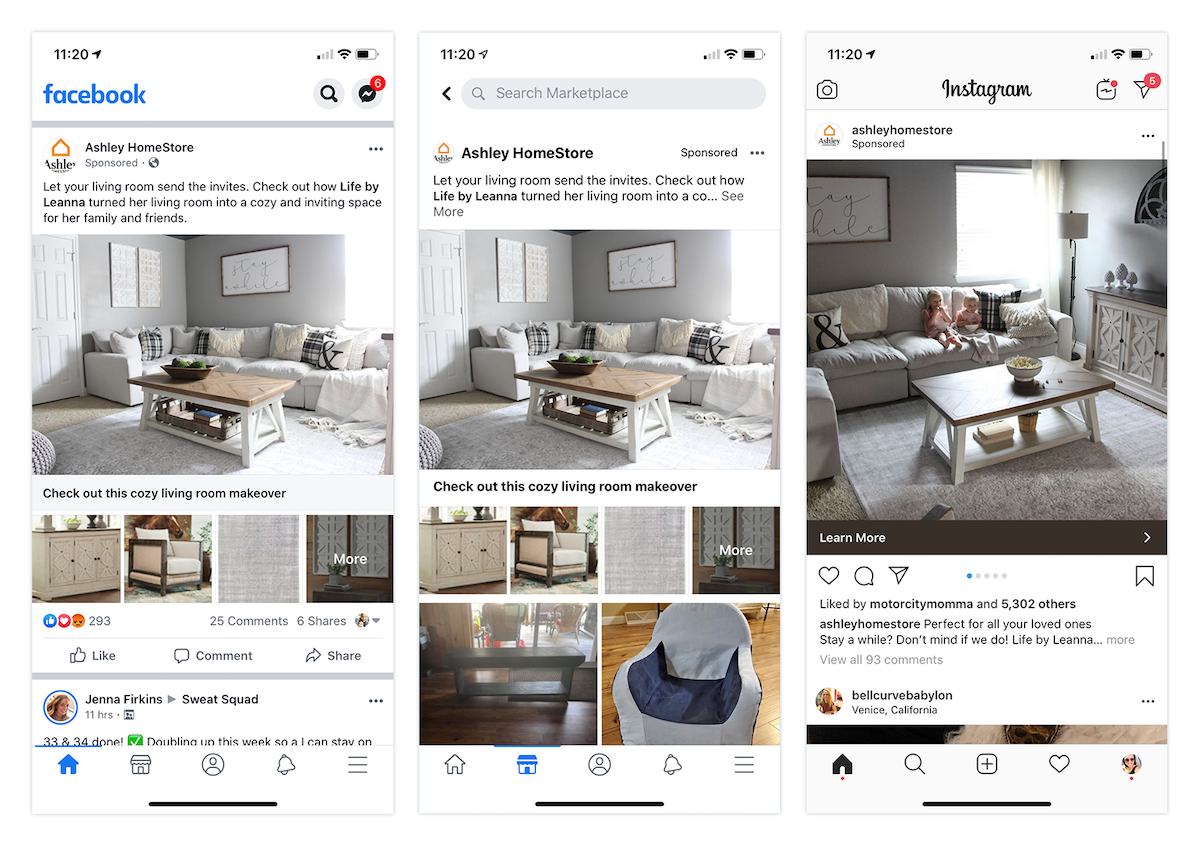
4. Produce more efficient outcomes
Since Automatic Placements allows advertisers to reach the entire Facebook family of apps and services, there are naturally more opportunities to achieve desired results efficiently.
A Facebook IQ study found that advertisers who took advantage of placement optimization campaigns saw 4.1% more reach and a 5.2% lower cost per impression, which led to a lower cost per reach of 5.8%. For the average campaign, this translated into an additional half million people reached for the same budget when compared to the Facebook-only ads.
Benefits for property managers and car dealerships
Rental property managers
Property managers can work with a Marketplace listing partner to list a broad selection of housing inventory for rent on Facebook Marketplace.
Some of the benefits to listing rental inventory on Marketplace include:
- Reaching prospects on Facebook where they’re already looking for homes for rent
- Collecting contact information through a simple lead capture form
- Offering additional search filters like number of bedrooms, square footage, and pet friendliness to more provide useful information
- Creating multi-unit listings when multiple units are available in the same building
Car dealerships
Dealerships can also use inventory partners to list their vehicle inventory on Marketplace and reach more people on Facebook. (Note: For best results, dealerships should work with only one inventory partner, because working with more than one may result in fewer leads from Marketplace.
Some of the benefits to listing vehicle inventory on Marketplace are:
- Increased visibility where people are already browsing vehicle listings
- Ability to quickly respond to questions via Facebook Messenger or a short instant form (depending on location)
- Showing additional useful information such as price, model, and mileage
Facebook doesn’t charge fees to list inventory on Marketplace, but there may be fees to work with listing partners.
How to post ads on Facebook Marketplace
1. Choose an ad objective from Ads Manager:
- Brand awareness
- Reach
- Traffic
- Video views
- Lead generation
- Messages
- Conversions
- Catalog sales
- Store traffic
2. Choose a Destination
3. Choose an Audience and define your targeting
4. Select “Automatic Placements” or “Edit Placements” (Automatic Placements is recommended, and if you choose Edit Placements, keep in mind your campaign must still include News Feed because Marketplace isn’t available as a single ad placement)
5. Set your Budget and Schedule
6. Choose your ad’s creative format and adhere to the following ad specs
Specs for Marketplace ads on Facebook
Marketplace ad specifications depend on the ad format you choose: single image, video, or carousel.
Image
Design Recommendations
- File type: jpg or png
- Image ratio: 9:16 to 16:9
- Recommended resolution: Upload the highest resolution image available
- Images that consist of more than 20% text may experience reduced delivery
- Text: 125 characters
With Link
- Images may be cropped to 1:1
- Recommended resolution: At least 1,200 x 1,200px
- Headline: 25 characters
- Link description: 30 characters
Video
Design Recommendations
- File type: Most file types are supported, however, H.264 compression, square pixels, fixed frame rate, progressive scan, and stereo AAC audio compression at 128kbps+ are recommended
- Recommended resolution: Upload the highest resolution source video available without letter or pillar boxing (no black bars), and that that meets file size and ratio limits.
- Video ratio: 9:16 to 16:9
- Video file size: 4GB Max
- Video length minimum: 1 second
- Video length maximum: 240 Minutes
- Video captions: Not supported
- Video sound: Optional but recommended
- Text: 125 characters
- Video thumbnail images that consist of more than 20% text may experience reduced delivery
- Vertical videos (with aspect ratio taller than 2:3) may be masked to 2:3
With Link
- Headline: 25 characters
- Link description: 30 characters
Technical Requirements
- Minimum aspect ratio: 200×300
Carousel
Design Recommendations
- Minimum number of cards: 2 (each with its own link)
- Maximum number of cards: 10 (each with its own link)
- Image file type: jpg or png
- Video file type: Supported file formats
- Video maximum file size: 4GB
- Video length: Up to 240 minutes
- Image maximum file size: 30MB
- Recommended resolution: At least 1080 x 1080px
- Recommended ratio: 1:1
- Text: 125 characters
- Headline: 25 characters
- Link description: 20 characters
- Images that consist of more than 20% text may experience reduced delivery
Technical Requirements
- Aspect ratio tolerance: 3%
In addition to the ad specs — and knowing how to place ads on Facebook Marketplace — there are also two main best practices to consider when creating your ad to appear on Marketplace.
2 Important best practices>
Sell locally
The majority of the products and services listed by users in the Marketplace are bought and sold locally — or at least within a certain radius that shoppers can set. So to succeed with the Marketplace ad placement, a local focus is key for businesses as well.
Use video
Half the challenge with any type of advertising is grabbing users’ attention. Unlike the Facebook News Feed, Audience Network, or even Instagram — Marketplace is dominated by static images, which means videos will stand out a lot more. Videos typically generate more leads than static images, and this is likely exaggerated in Marketplace.
Case study examples
Many businesses are seeing positive campaign results using automatic placement and ads in Marketplace. Here are a few:
Thread Wallets
This accessories company immediately tested the Marketplace placement as soon as it became available in February 2018. From February 10 to March 5, 2018, the Thread Wallet Marketplace ad campaign resulted in:
- Over 350 purchases from ads in Marketplace
- 16% decrease in cost per click, year over year
- 17% decrease in cost per conversion (purchase), year over year
- 41% increase in return on ad spend, year over year
FabFitFun
The newly popular women’s lifestyle subscription box and media company increased its subscription base by advertising on Facebook, with Marketplace ads generating a 2.2X return on ad spend.
Alyssa Perry, Acquisition Marketing Director of FabFitFun testified:
Marketplace is the perfect place to drive membership for our subscription boxes. We’ve seen lower cost per acquisition for campaigns that include Marketplace and have opted into this placement for all of our campaigns.
BarkBox
BarkBox ran a Facebook split test for its conversion campaign, evenly dividing their audience into two groups: one with people who were served video ads in News Feed only, and another who were shown video ads in News Feed and Marketplace.
The split test results showed that the campaign performed better when ads were shown in both Marketplace and News Feed, compared to News Feed alone. BarkBox’s 2-week campaign produced:
- 16% higher conversion rate
- 8% lower cost per conversion
- 49% greater reach
According to the BarkBox Growth Team:
Placement in Facebook Marketplace allowed BARK to extend the reach and scale of our campaigns, positioning us to garner more conversions at a slightly lower cost. At our scale, even incremental improvement means a lot of return on investment for our business.
Reach customers where they’re shopping with Marketplace ads
Facebook Marketplace Ads enable you to reach users who are actively browsing for products to buy and already have purchase intent. What better way to target someone than that?
Don’t let this opportunity go to waste, though — ensure your conversion rates increase right along with your ad reach. That means providing all of your customers with a unique, personalized post-click landing page. To see how to put this in action today, get an Instapage Enterprise demo.

See the Instapage Enterprise Plan in Action.
Demo includes AdMap™, Personalization, AMP,
Global Blocks, heatmaps & more.
